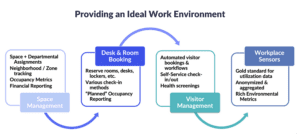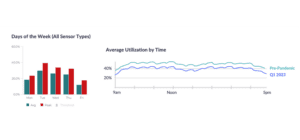Over the last few years, businesses have been on a journey to workplace transformation and real estate portfolio optimization. After rapid adoption of remote work to ensure employee safety during the pandemic, organizations slowly brought employees back to the office—some full-time and others in a hybrid work arrangement. A hybrid workplace model mixes in-office work with remote work to offer employees more flexibility.

Hybrid employees generally work with greater autonomy and enjoy a better work-life balance. The hybrid workplace offers employees a better connection with colleagues and sense of purpose than fully remote work. A 2023 Gallup workplace survey revealed employees in a hybrid workplace technology arrangement have a stronger connection with the company’s mission and purpose than fully remote and in-office peers.
What do companies need to do to experience the most success with the hybrid workplace model? In this article, we will share some best practices for optimizing employee experiences, buildings, and technology to empower hybrid work.
Deliver Ideal Workplace Experiences
Businesses need a healthy balance of people, processes, and tools to succeed. When it comes to hybrid work, it is important to start with an understanding of your people and their expectations about work and workplace. It is essential to provide an engaging workplace along with easy-to-use workplace tools. Today’s workplace needs to accommodate up to five generations with varying degrees of comfort and intuition around technology.
Here are three ways businesses can plan and deliver ideal hybrid work experiences:
- Emphasize the social aspects of the office. Humans form deeper team bonds through in-person interaction, and meeting as a group can be essential to collaboration and idea generation. A work trends survey by Microsoft found 85% of employees would be motivated to come into the office in order to rebuilt team bonds. Gen Z and Millennials especially want social interaction with co-workers and better connection with their managers and senior leadership.
- Meet people where they are with workplace technology. Employees need to be able to search and reserve spaces in different ways, in different locations. From home, they will probably book a desk or meeting room using a web browser or mobile phone. In the office, they may prefer using kiosks, QR codes and digital signage.
- Use data to assess the work environment. Take employee feedback and usage trends into account when planning the workplace. First, it’s critical to understand how much space you have and who is assigned to each space whether you plan for departments or neighborhoods/zones. Next, collect occupancy data through desk and room bookings or occupancy sensors. You can analyze which spaces perform best for your workforce and ensure healthy environments in terms of cleaning and air quality.

Manage Buildings for Efficiency and Sustainability
Office space accounts for the second-highest operations cost for most businesses, after labor costs. With hybrid work becoming a permanent feature of the workplace, businesses have to look at their portfolio of space and identify ways to use space more efficiently.
As organizations strive to do more with less, both hybrid work and net zero sustainability objectives are factoring into how buildings are managed and used. Businesses have to navigate changing work patterns and evolving employee preferences to manage hybrid work. Businesses are also under pressure to reduce emissions and improve sustainability as governments worldwide committed to achieving net zero by 2050.
Two of the main contributors to CO2 emissions are the energy required to run buildings and the transportation used by commuting workers. Building operations are responsible for about 27% of global CO2 emissions. Newer buildings can be much more energy efficient; however, most commercial building stock that will be available in 2050 was built in the past. Remote working and moving offices closer to where most employees live can reduce transportation emissions.
Businesses have an opportunity to reduce leased space—lowering costs and reducing their carbon footprints—by improving workplace efficiency. Unfortunately, a recent survey of facilities management professionals and business leaders showed:
- 44% lack accurate utilization data
- 32% lack accurate space data
 With the right data, business leaders can measure and improve building utilization while conserving utilities and reducing emissions. The following types of solutions embolden more data-driven decisions around portfolio changes, mixture of space types, and utility conservation:
With the right data, business leaders can measure and improve building utilization while conserving utilities and reducing emissions. The following types of solutions embolden more data-driven decisions around portfolio changes, mixture of space types, and utility conservation:
- Space and asset management
- Utilization data
- Strategic planning and move management
- Environmental data
Optimize the Hybrid Workplace
Employers want employees into the office more, and many are turning to both design and technology to entice employees to come in. According to PwC’s Emerging Trends in Real Estate report, 10% to 20% of office real estate stock may need to be removed from corporate portfolios or repurposed for different utilization. To support hybrid employees, businesses will need an optimized workplace strategy and the right combination of amenities, spaces, design and technology.
Creating a pleasant, productivity-enhancing workplace requires intention and focus to build up these qualities:
- Social: To appeal to employees’ desire to forge deeper relationships with colleagues, designers are adding more tech-enabled collaboration spaces and social areas with amenities such as food and beverages for employees to enjoy.
- Team-oriented: Many companies have adopted neighborhood or zone space plans to keep teams close together.
- Soothing: Top design focuses center on enhancing employee mental and physical well-being, including biophilic design, outdoor spaces, and gyms and wellness amenities.
- Convenient: Some businesses are pursuing a strategy to create smaller, smarter workplaces sited in multiple locations to offer employees a better commute.
- Healthy: Facilities managers are paying close attention to health and employee comfort by using smart building systems to automatically adjust temperature and air quality based on real-time environmental sensor data.
Drive Decisions with Workplace Management Technology
To stay agile and respond to changing workplace trends and employee preferences, businesses need a holistic view of space and utilization. Manual spreadsheets won’t cut it anymore.

Workplace management technology helps businesses gather and analyze data to support hybrid workers, deliver better experiences, improve the efficiency and sustainability of buildings, and optimize real estate portfolios. To learn more about how businesses are leveraging workplace analytics to support the hybrid model watch our on-demand webinar series on the Tenets of Hybrid Work.










